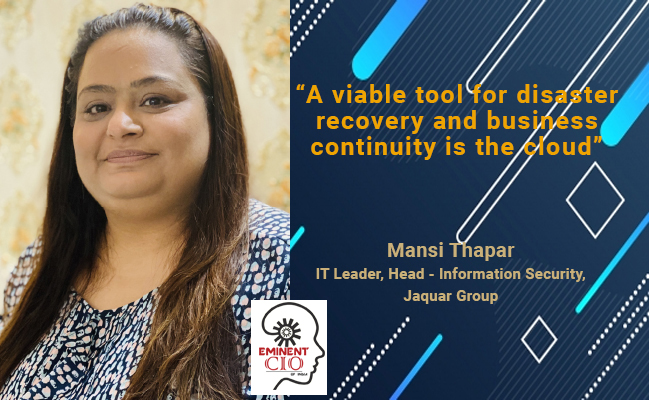“A viable tool for disaster recovery and business continuity is the cloud”
By MYBRANDBOOK

Mansi Thapar IT Leader, Head - Information Security, Jaquar Group
Cloud bring opportunity
Besides keeping critical data, applications and processes secure and the network running 24x7, modern IT departments are under constant pressure to implement new technologies that enable the business. Due to this, business continuity planning and disaster recovery often takes a back seat to the day-to-day challenges of managing IT for an enterprise. But failure to prepare adequately for technological or natural disasters that disrupt the business could lead to financial disaster. A viable tool for disaster recovery and business continuity is the cloud. Because cloud computing relies heavily on hardware-independent virtualization technology, it enables enterprises to quickly back up data, applications, and even operating systems to a remote data center (or cloud). Faster uploads and downloads of important computing elements naturally translate into faster recovery times for the business.
Cloud based business continuity has made achieving operational resiliency easier, faster and more economical. Organizations now have the luxury of tackling downtime – the bane of any business that can stall production and impact revenue – seamlessly. And the benefits for organizations who take business continuity to the cloud are immense. Availability, easy restoration and back-ups, anytime / anywhere and cost effectiveness has paved the way for cloud acceptance for business continuity planning in various organisations.
Cloud: A catalyst of Growth
Fast pace of digital disruption demands that businesses must respond promptly to changing customer and employee needs. But often, a major hurdle is the need for huge capital investments in technology, longer time to market, and the operational overheads like IT staff etc. needed to maintain such systems. In all the above cloud computing comes to the rescue especially during this COVID time when many companies are seeking increased agility, flexibility, scalability with cost effectiveness. Cloud Computing has the flexibility of offering a “pay per use” feature that enables businesses to pay only for services in use, helping lower operating costs, run their infrastructure more efficiently and scale as business needs change. This has made a huge impact on adoption of cloud. Other benefits include Security, disaster recovery, mobility, insight, increased collaboration, quality control, loss prevention, automatic software updates, competitive edge and sustainability.
Hybrid Cloud
If an organisation has a hybrid cloud they have to deal with security. Whether it is pairing private and public cloud or running a complex, multi-cloud architecture, security is one of those areas where organisations can throw a lot of technology at the problem without getting results. What is needed is the precise mix of strategy and planning, followed by technology selection. Also, a key component in the mix is a single security toolset that covers public, private, and on-premises systems.



Legal Battle Over IT Act Intensifies Amid Musk’s India Plans
The outcome of the legal dispute between X Corp and the Indian government c...

Wipro inks 10-year deal with Phoenix Group's ReAssure UK worth
The agreement, executed through Wipro and its 100% subsidiary,...

Centre announces that DPDP Rules nearing Finalisation by April
The government seeks to refine the rules for robust data protection, ensuri...

Home Ministry cracks down on PoS agents in digital arrest scam
Digital arrest scams are a growing cybercrime where victims are coerced or ...


Icons Of India : Anil Agarwal
Anil Agarwal, the Founder and Chairman of Vedanta Resources Ltd., is r...

ICONS OF INDIA : SACHIN BANSAL
Sachin Bansal is an Indian entrepreneur. He is best known as the found...

ICONS OF INDIA : VIJAY SHEKHAR SHARMA
Vijay Shekhar Sharma is an Indian technology entrepreneur and multimil...


C-DOT - Center of Development of Telematics
India’s premier research and development center focused on telecommu...

NPCI - National Payments Corporation of India
NPCI is an umbrella organization for operating retail payments and set...

ECIL - Electronics Corporation of India Limited
ECIL is distinguished by its diverse technological capabilities and it...


Indian Tech Talent Excelling The Tech World - Lal Karsanbhai, President & CEO, Emerson
Lal Karsanbhai, President and CEO of Emerson, assumed the leadership i...

Indian Tech Talent Excelling The Tech World - PADMASREE WARRIOR, Founder, President & CEO - Fable
Padmasree Warrior, the Founder, President, and CEO of Fable, is revolu...

Indian Tech Talent Excelling The Tech World - Dheeraj Pandey, CEO, DevRev
Dheeraj Pandey, Co-founder and CEO at DevRev , has a remarkable journe...
 of images belongs to the respective copyright holders
of images belongs to the respective copyright holders